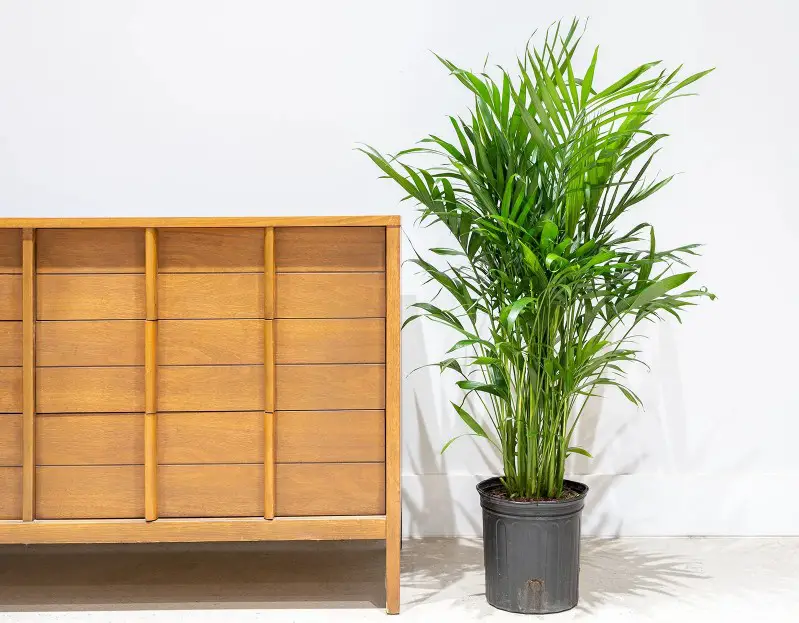Cat palm, also known as cascade palm or cataract palm (Chamaedorea cataractarum), is a popular indoor plant thanks to its elegant, feathery fronds and ease of care. Native to tropical climates, this perennial thrives in indoor environments when provided with the right conditions.
Whether you’re a beginner or an experienced plant parent, this guide will give you the most detailed tips on how to care for a cat palm indoors and keep it thriving.
Can Cat Palms Thrive Indoors?

Absolutely! Cat palms are well-suited for indoor living, as they love the warm temperatures and moderate humidity that indoor spaces provide. With proper care, including indirect light and the right watering routine, these plants can grow into vibrant, lush additions that infuse any room with a touch of tropical elegance.
Key Characteristics of Cat Palm:
- Common Names: Cat palm, cascade palm, cataract palm
- Botanical Name: Chamaedorea cataractarum
- Plant Type: Perennial
This guide covers all aspects of cat palm care, from ideal lighting conditions to watering and fertilizing, so your plant can thrive indoors.
Tips for Growing Cat Palm Indoors
Light Requirements
Cat palms thrive in bright, indirect light. Direct sunlight, especially in the afternoon, can scorch the leaves, causing them to turn brown or yellow. However, soft morning light from an east-facing window is generally safe. If your plant isn’t getting enough light, its growth will slow and the fronds may lose their vibrant green color.
Tip: Rotate your cat palm every few weeks so that all sides of the plant get equal light exposure.
Ideal Temperature and Humidity
Cat palms prefer moderate indoor temperatures ranging from 70 to 80°F (21 to 27°C) during the day and slightly cooler at night, around 60°F (16°C). Avoid exposing the plant to temperatures below 50°F (10°C), as this can damage its leaves.
These plants thrive in a humidity level of 50% or higher. You can increase humidity by using a humidifier, placing a water tray near the plant, or grouping it with other houseplants.
Watering Your Cat Palm
One of the most common mistakes in cat palm care is overwatering. Water the plant when the top inch of the soil feels dry. Ensure the pot has good drainage, and never let the roots sit in water, as this can cause root rot.
Tip: Use a moisture meter to check the soil’s moisture level. If it’s too wet, hold off on watering.
Fertilizing
Cat palms benefit from monthly fertilization during the growing season (spring and summer). Use a balanced liquid fertilizer, diluted to half strength, to avoid overwhelming the plant. Stop fertilizing in the fall and winter when the plant’s growth slows.
Best Potting and Soil Tips for Cat Palm
Choosing the Right Container
When selecting a pot for your cat palm, opt for terracotta or clay pots. These materials help wick away excess moisture, preventing root rot. Choose a pot that is only slightly larger than the root ball to avoid excessive soil moisture retention.
Best Potting Soil for Cat Palm
Cat palms prefer a well-draining potting mix. You can use a pre-mixed soil designed for palms, or you can make your own by combining standard potting mix with equal parts pine bark and perlite. This mix will help retain moisture without becoming waterlogged.
Pruning and Maintenance of Cat Palm
Cat palms are relatively low-maintenance plants and don’t require regular pruning. However, it’s a good idea to occasionally tidy them up by removing any yellow, dead, or damaged fronds. Use clean, sharp pruning shears to avoid introducing bacteria or diseases to the plant.
Potting and Repotting Your Cat Palm
Cat palms are slow-growing plants, so you won’t need to repot them frequently. Generally, repotting every two to three years is sufficient. When repotting, choose a pot that is only slightly larger than the current one.
- Gently remove the plant from its old pot, being careful not to damage the roots.
- Place it into the new container with fresh, well-draining soil.
- Water thoroughly after repotting.
Note: These plants do not respond well to having their roots disturbed, so it’s better to let them become slightly potbound before repotting.
Taking Your Cat Palm Outdoors in the Summer
To help your cat palm thrive during the summer, you can move it outside for a period of time. However, be mindful of a few important factors to ensure the plant stays healthy:
Temperature Considerations
Cat palms thrive in temperatures above 55-60°F (13-16°C). Do not place them outdoors until the weather consistently stays within this range. Avoid exposing them to frost or freezing conditions.
Lighting Outdoors
When moving your plant outdoors, place it in partial or dappled shade to avoid sunburn. Gradually transition the plant to outdoor conditions over a few days to prevent shock.
Bringing Your Cat Palm Back Indoors
As the temperatures start to dip in the fall, bring your cat palm back inside. Be sure to inspect the plant for pests before reintroducing it to your indoor environment.
Common Issues and Troubleshooting
Why is My Cat Palm Turning Yellow or Brown?
One of the most common problems with cat palms is yellowing or browning fronds. This is often caused by too much direct sunlight or overwatering. Ensure your plant receives only indirect light, and check the soil’s moisture level before watering.
Dealing with Root Rot
If your plant’s roots are consistently wet, it may develop root rot, a serious condition that can kill the plant. To avoid this, ensure your pot has good drainage and use a well-draining soil mix.
Propagating Cat Palm
If you have a mature cat palm, you can propagate it through division. Here’s how:
- Carefully remove the plant from its pot.
- Look for natural separations in the root system.
- Using a clean knife, divide a section with roots and plant it in a new pot with fresh soil.
- Water thoroughly and place it in a bright, indirect light spot.
Final Thoughts
Cat palms are graceful and easy to care for, making them a great choice for indoor spaces. With the right balance of light, temperature, watering, and a little maintenance, these plants can thrive indoors for years. In return, they’ll reward you with their lush, green fronds and a refreshing tropical vibe.






